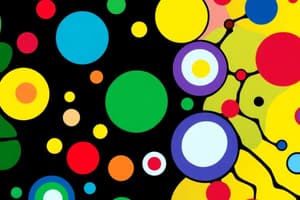Podcast
Questions and Answers
What distinguishes one cell from another?
What distinguishes one cell from another?
Cell theory states that all living things are made of cells, cells are the basic structural and functional units of organisms, and all cells come from pre-existing cells.
How do cells coordinate activities within their internal and external environments?
How do cells coordinate activities within their internal and external environments?
Cells coordinate activities through communication and signaling mechanisms.
How are cells arranged in a multicellular organism?
How are cells arranged in a multicellular organism?
Cells in a multicellular organism are arranged into tissues, organs, and systems.
What is the difference in nutrient and gas requirements between autotrophs and heterotrophs?
What is the difference in nutrient and gas requirements between autotrophs and heterotrophs?
How do environmental pressures promote a change in species diversity and abundance?
How do environmental pressures promote a change in species diversity and abundance?
How do adaptations increase the organism's ability to survive?
How do adaptations increase the organism's ability to survive?
What is the relationship between evolution and biodiversity?
What is the relationship between evolution and biodiversity?
What is the evidence that supports the Theory of Evolution by Natural Selection?
What is the evidence that supports the Theory of Evolution by Natural Selection?
What effect can one species have on other species in a community?
What effect can one species have on other species in a community?
How do selection pressures within an ecosystem influence evolutionary change?
How do selection pressures within an ecosystem influence evolutionary change?
How can human activity impact an ecosystem?
How can human activity impact an ecosystem?
What type of cells are prokaryotes?
What type of cells are prokaryotes?
Which of the following is a function of ribosomes?
Which of the following is a function of ribosomes?
Which structure separates the chromosomes from the rest of the cell?
Which structure separates the chromosomes from the rest of the cell?
What is one of the four main structures found in prokaryotic cells?
What is one of the four main structures found in prokaryotic cells?
Flashcards are hidden until you start studying
Study Notes
Module Overview
- Module 1 examines cells as the fundamental units of life and their coordination within environments.
- Module 2 explores the organization of living organisms, including arrangements of cells and differences in nutrient needs.
- Module 3 focuses on biological diversity, including environmental impacts on species, adaptations for survival, and the relationship between evolution and biodiversity.
- Module 4 discusses ecosystem dynamics, including species interactions and human impact on ecosystems.
Cell Theory
- All organisms are composed of cells.
- Cells are the basic structural and functional units of life.
- New cells arise only from pre-existing cells.
Types of Organisms
-
Unicellular Organisms:
- Composed of a single cell (e.g., bacteria, protozoa).
- Oldest life forms, existing for 3.8 billion years.
- Obtain nutrients through phagocytosis.
-
Multicellular Organisms:
- Consist of multiple cells (e.g., humans, dogs).
- Cells collaborate to perform various bodily functions.
- Types include nerve cells, skin cells, blood cells, and bone cells.
Classification of Cells
-
Prokaryotes:
- Smaller and simpler than eukaryotes.
- Lack membrane-bound organelles.
- Divided into Archaea and Bacteria.
- Reproduce via binary fission.
- Key structures: cell membrane, cytoplasm, ribosomes, genetic material in the nucleoid.
-
Eukaryotes:
- Larger and more complex than prokaryotes (10-100 µm).
- Comprise multicellular plants and animals as well as some unicellular organisms.
- Divide through mitosis.
Similarities Between Cell Types
- Both prokaryotes and eukaryotes contain:
- DNA
- Cell membrane for selective permeability
- Ribosomes for protein synthesis
- Cytoplasm housing organelles.
Organelles Overview
-
Cytoplasm:
- Liquid medium holding various dissolved substances.
- Protects organelles and maintains cell shape.
-
Nuclear Membrane:
- Separates chromosomes from the cytoplasm.
- Pores allow selective material exchange (nucleic acids and proteins) between nucleus and cytoplasm.
-
Nucleus:
- Large, spherical structure housing DNA.
- Functions include DNA storage, cell growth, reproduction, and ribosome production.
-
Ribosomes:
- Structures responsible for protein synthesis.
- Found both freely floating in cytoplasm and attached to endoplasmic reticulum (not detailed in the text).
Studying That Suits You
Use AI to generate personalized quizzes and flashcards to suit your learning preferences.




